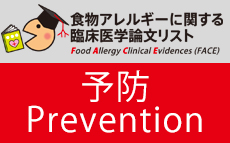アナフィラキシーにおける専門医診療とアドレナリン自己注射の系統的レビューと費用対効果の解析/A systematic review and cost-effectiveness analysis of specialist services and adrenaline auto-injectors in anaphylaxis.
更新日:2016年10月21日
| Author: | Armstrong N, Wolff R, van Mastrigt G, Martinez N, Hernandez AV, Misso K, Kleijnen J. |
|---|---|
| Title: | A systematic review and cost-effectiveness analysis of specialist services and adrenaline auto-injectors in anaphylaxis. |
| Citation: | Health Technol Assess. 2013 Apr;17(17):1-117, v-vi. doi: 10.3310/hta17170. |
| URL: | https://pubmed.ncbi.nlm.nih.gov/23618619/ |
| Abstract: | BACKGROUND:Anaphylaxis is a severe, life-threatening generalised or systemic hypersensitivity reaction with high mortality. Specialist services (SSs) are believed to reduce anaphylaxis recurrence and improve use of adrenaline injectors (AIs), which can reduce mortality if used correctly and in time. OBJECTIVES:To review the evidence on which persons are at high risk of anaphylactic episodes, the effects of history-taking (including signs, symptoms and physical examination) for anaphylaxis, and when (suspected) patients should be referred. To assess the cost-effectiveness of SS compared with standard care (SC) with or without prescription of AIs. DATA SOURCES:In order to assess the clinical effectiveness, 10 databases [Cochrane Database of Systematic Reviews (CDSR), Cochrane Central Register of Controlled Trials (CENTRAL), Database of Abstracts of Reviews of Effects (DARE), Health Technology Assessment (HTA), NHS Economic Evaluation Database (NHS EED), Science Citation Index (SCI), Cumulative Index to Nursing and Allied Health Literature (CINAHL), EMBASE, MEDLINE, MEDLINE In-Process & Other Non-Indexed Citations, from inception up to March 2011] were searched without data restriction in order to identify relevant studies [randomised controlled trials (RCTs), controlled clinical trials, observational studies, prognostic studies using a multivariate model] written in English. REVIEW METHODS:Standard review methods were applied for the assessment of clinical effectiveness. A Markov model, validated by clinical experts, was constructed, which modelled anaphylaxis according to trigger: either food, drug, insect or idiopathic. Anaphylaxis mortality was modelled as a function of time to die and time for emergency response. Probabilistic sensitivity analysis on key parameters was performed. RESULTS:From the systematic review, 11,058 references were identified by the searches for studies assessing the clinical effectiveness. In total, 107 papers were obtained, and five prospective observational studies, including 1725 patients, were included. These studies estimated the risk of recurrence to be between 30% and 42.8%. In children (< 12 years), an overall recurrence of 27% was reported, with food being the most frequent allergen (71%). From the cost-effectiveness analysis (CEA), SC with injectors was dominated by SS with or without injectors. SS with no injectors would be cost-effective if the threshold for a quality-adjusted life-year (QALY) was greater than about £ 740 and with injectors would be cost-effective if the threshold was > £ 1800. These results were robust to all sensitivity analyses except at relatively extreme values of a small number of parameters. LIMITATIONS:Limitations of the study include the low yield from the systematic review; in particular there were no good-quality studies of either SSs or AI effectiveness. This implied a great reliance on expert opinion in the CEA. However, this was appropriately addressed using sensitivity analysis. CONCLUSIONS:Only five observational studies assessing clinical effectiveness were identified. Owing to the lack of good data to inform the effectiveness of anaphylaxis intervention, we recommend considerations of RCTs or at least well-designed observational studies of the components of care in SSs. The results of the CEA showed that SS with AIs was cost-effective at a threshold of £ 20,000 per QALY. More well-designed prospective studies on the effectiveness of SSs are needed to confirm these findings. |
| 邦文タイトル: | アナフィラキシーにおける専門医診療とアドレナリン自己注射の系統的レビューと費用対効果の解析 |
| 一般向け要約 | アナフィラキシーは死亡率が高く、重篤で生命の危険がある全身性の過敏反応である。専門医による診療はアナフィラキシーの再発を減少させ、アドレナリン自己注射の正しいそして適切なタイミングでの使用を促進し、死亡率を減少させることができると考えられている。この論文では専門医の診察を非専門医と比較し、アドレナリン自己注射の処方の有無に関する費用対効果を評価した。10のデータベースを用いて2011年3月までに報告された11,058論文から基準を満たす合計1725人を対象とした107論文を抽出した。これらの研究ではアナフィラキシーの再発リスクは30−42.8%と推定された。小児(<12歳)では27%の再発があり、食物が最も多い(71%)原因でした。費用効果分析からはアドレナリン自己注射を処方した非専門医の診療が大きく影響していた。アドレナリン自己注射を処方しない専門医診療は、質調整生存年(QALY)あたりで約740ポンドより高くても良い場合は効率的で、アドレナリン自己注射を処方する専門医診療はQALYあたり1800ポンドより高くても良い場合は効率的であった。 QALYあたり20,000ポンドまでであれば、アドレナリン自己注射を処方する専門医診療が効率的であることが示された。 |
| 専門医コメント | アナフィラキシーに対してアレルギー専門医がアドレナリン自己注射を処方し、アドレナリン自己注射を正しく使用する方法を指導することにより費用対効果が得られることを述べたレビューです。 質調整生存年(QALY)とは、生活の質のよさ(0~1)に年数を掛け算した値です。この計算では「最高の生活(1)が1年続くこと(1x1=1QALY)」が「真ん中くらいの質の生活(0.5)が2年続くこと(0.5x2=1QALY)」と同等となります。 |

